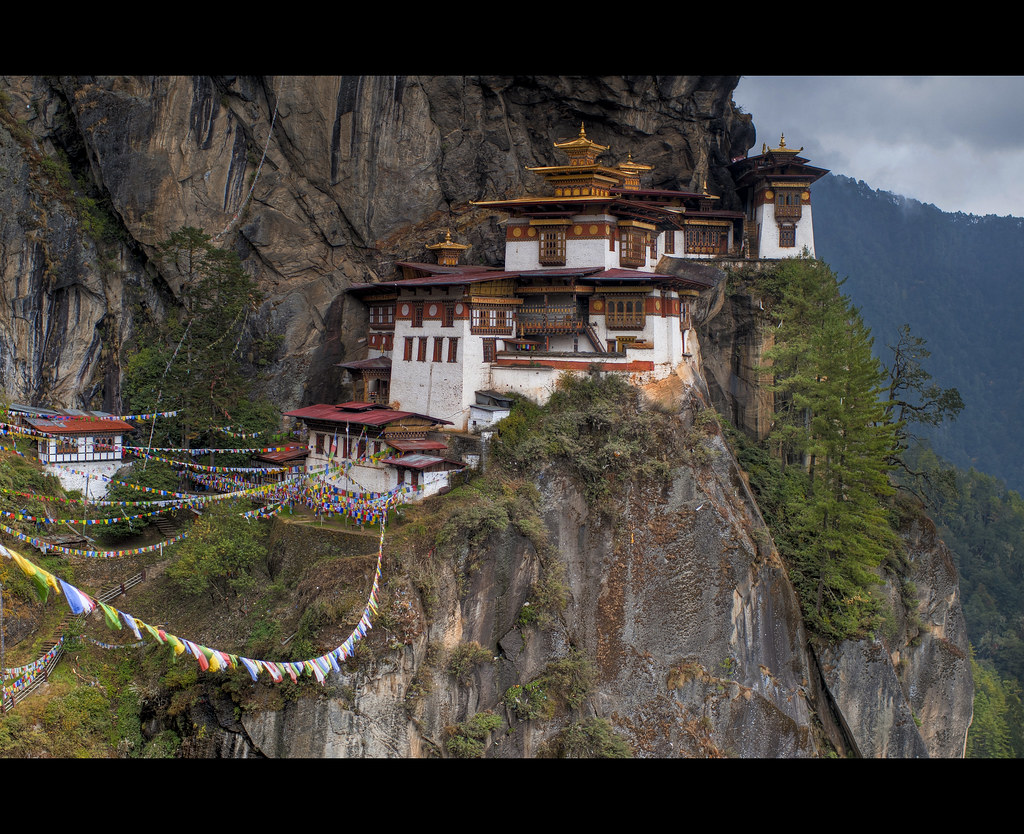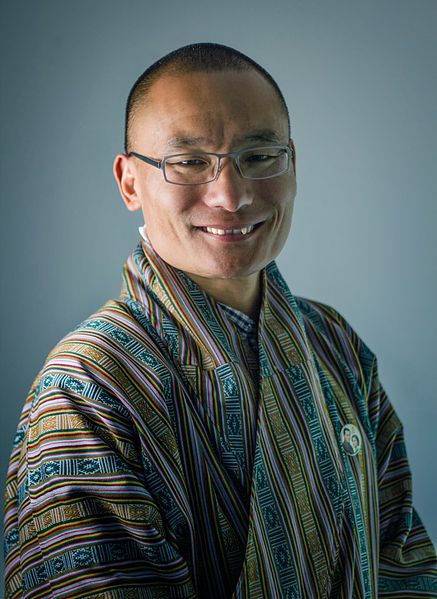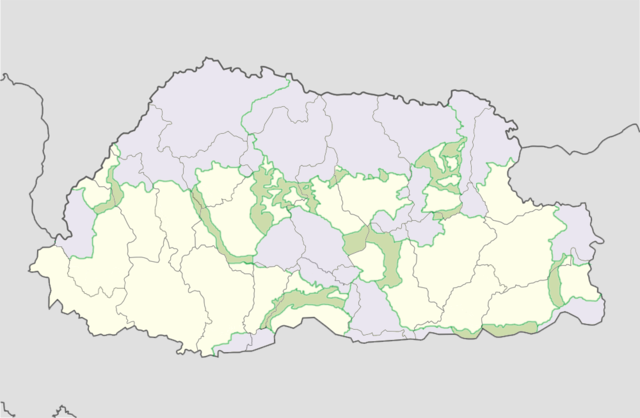
(Wikimedia Commons)

(Wikimedia Commons)
The Kingdom of Bhutan has attempted to get the world’s attention for years, but not many listened until the Paris Agreement. They wrote off the tiny Himalayan, landlocked state as irrelevant, even though the carbon emissions reduction model brought about carbon-neutrality, a nation that has offset its own carbon emissions, and eventually carbon-negativity, a nation that diminishes greenhouse gases already built up in the atmosphere itself.
The nation was able to achieve carbon-negative status through four steps: Establishing a Gross National Happiness (GNH) Index; creating a unique approach to sustainability; developing a strong environmental governance and policy; encouraging a diversification of the national economy.
In a world that has become more interconnected and polarized simultaneously due to globalization, it is important to observe these Bhutanese initiatives individually. First, and most significantly, is the unique way in which the nation tracks productivity: their Gross National Happiness.
The “Gross National Happiness Index,” or GNH, is the measurement of the collective happiness in a nation. The concept entails a holistic approach toward economic progress while also asserting equal importance to non-economic indicators of development. Essentially, the GNH is an alternative form of measuring national productivity to Gross Domestic Product (GDP).
Despite the Bhutanese government’s use of GNH as a main productivity factor, the government still holds productivity and economic success in high regard. However, the concept of Gross National Happiness set the precedent for environmental and conservation policy in Bhutan.

Former Prime Minister of Bhutan Tshering Tobgay conveys this sentiment in his 2014 TED Talk when he admits that “economic growth is important, but that economic growth must not come from undermining our unique culture or our pristine environment.”
So how does the GNH index actually work? The concept of Gross National Happiness can be broken down into four pillars: good governance, sustainable and socio-economic development, cultural preservation, and environmental conservation.
Good governance is how fair and responsible the government, both federal and local, is in leading the people of Bhutan.
Sustainable and socio-economic development is the process by which businesses and the well being of people improve over time.
Cultural preservation is the maintenance of Buddhist values and traditions through government-sponsored initiatives.
Environmental conservation is how well Bhutan’s forests, mountains, and wild-life reservations are protected through government and business policy.
As of 2015 and the third iteration of this index, 43.4 percent of Bhutanese are deeply or extremely happy and 91.2 percent of the people are sufficient in five or more of the domains.
But how did this rapid increase in personal happiness come to be in just five years?
Environmental policy is encouraged and deeply rooted in the GNH concept. After all, one of the four pillars of GNH is environmental conservation. Additionally, one of the nine domains in evaluating happiness is ecological diversity and resilience.
A history of ethnic tensions between the Buddhist, Bhutanese majority and Nepali minority have prompted questions about the GNH model. Despite the controversy surrounding particular government decisions, it does not compromise the concept of Gross National Happiness today because controversy is measured on a number of indicators that safeguard any type of prejudice, be it along spiritual, religious, or ethnic lines.
In summation, Gross National Happiness is an effective socio-economic model because it provides public insight into policy. Polling gathered from GNH Indices encourages government institutions like the National Environmental Commission to pass environmental laws, all of which contributes to Bhutan’s carbon-negative status. Additionally, the Indexes provided insight into potential sustainable development projects that could benefit Bhutanese citizens struggling to find jobs.
Sustainable development is economic development that does not compromise the current and future populations of a nation. This balance can be difficult to maintain when there are various interest groups that will endorse policy beneficial to their own agendas. For example, the American Oil and Natural Gas lobby and the Natural Resource Defense Council (NRDC) will speak in the House of Representatives to promote their own interests. In Bhutan, there are various influences and contrasting opinions that have resulted in meaningful policy writing — but that will likely be swept under the rug, so to speak.
In an article titled “Bhutan: A Review of Its Approach to Sustainable Development,” Bob Frame writes that “the strong, centralized, government-led agenda (rather than a donor-driven one) provides a secure sense of national cohesion on policy issues and one that donors respect and use as an example of good practice.”
This allegation is easily justifiable. A government that entertains deals or treaties with foreign businesses and governments may be more susceptible to outside influence in domestic affairs. These international entanglements have led to conflict in the past.
As Frame puts it: “Bhutan has been careful to maximise the benefits of its ‘brand image’ internationally and to reduce the impact of mitigating factors. As a result it maintains, for now, its reputation as a ‘Shangri-La’ destination for tourism and for development, with the likelihood that this will continue to ensure a steady flow of donor and private-sector (including academic and student exchange) funds for some time to come.”
Instead, the Bhutanese government centers its focus for sustainability investments into national programs and forge deals with particular nations in support of the aforementioned programs.
One national project utilized nearly $13 million in funding from the Asian Development Bank (ADB) and Germany. This project “will build new training centres, rehabilitate others, and strengthen links to the private sector including providing career counseling and job-placement services,” all of which benefited the Bhutanese economy and the happiness of the Bhutanese people.
As previously mentioned, 98% of all Bhutanese have some level of happiness for the government and its policies. Additionally, the Bhutanese government-led another project that invested in sustainable transport and subsidized the purchase of electric vehicles, according to the latest GNH Index report. The government also subsidized the cost of LED lights. Environmentally friendly initiatives enacted in the past two decades have helped preserve Bhutan’s carbon-neutral status and brought about its carbon-negative status.
Some critics are doubtful of these initiatives because of ethnic tensions between the government and the people. Ethnic discrimination against certain social groups in Bhutan, particularly on Nepali-born Bhutanese, have in the past led to turbulent social and political movements, as well as harsh international criticism.
Journalist Joseph C. Mathew critiques the anti-Nepali propaganda fabricated by a previous Bhutanese king and government in his article. Former prime minister Jigme Y. Thinley was, in the 1980s, a bureaucrat who endorsed a series of laws that restricted the rights of certain Bhutanese citizens, otherwise known as the Bhutanisation Drive. He was known to have “articulated the stereotypical ‘Nepalese aggressiveness’ which threatened the integrity of Bhutan.”
In spite of ethnic stereotyping, Thinley helped usher in the Gross National Happiness Index to help improve the quality of life for all of Bhutan’s citizens.

Environmental conservation is of utmost importance in Bhutanese politics. In his 2016 TED Talk, Prime Minister Tobgay shared how the government’s environmental awareness translated into conservation policy.
He announced, “Today, more than half our country is protected as national parks, nature reserves, and wildlife sanctuaries. But the beauty is that we’ve connected them all with one another through a network of biological corridors. Now, what this means is that our animals are free to roam throughout our country.”
Technically, Tobgay was not completely accurate. Bhutan’s official protected areas do not just make up 50 percent, but in fact, claim 70 percent of Bhutan’s total land area. How is this possible? The Bhutanese Constitution explicitly enforces the protection of Bhutan’s wildlife, incentivizing the government and businesses alike to uphold an environmentally conscious perspective.
Line three of Article five of the 2008 Bhutanese constitution states, “The government shall ensure that, in order to conserve the country’s natural resources and to prevent the degradation of the ecosystem, a minimum of 60 percent of Bhutan’s total land shall be maintained under forest cover for all time.”
This particular line, as well as all others in this article, prevent the government from pursuing policy that would destroy or harm protected areas. King Jigme Singye Wangchuck, author of the 2008 Bhutanese Constitution, cared deeply about the future of Bhutan’s wildlife and natural habitats. Seeing the industrialization of developing countries and the toll it took on the quality of life for their people, the king wrote in the constitution a means to protect the land from mass industrialization.
A majority of the Bhutanese people, many of whom live in urban areas, look highly upon stricter environmental and conservation laws.
Mani Ram Moktan, journalist for the International Mountain Society, submitted a report on the use of and transition from firewood as the people’s main energy source. In his report Moktan said, “Urban respondents overwhelmingly chose electricity as an oak firewood substitute because it was associated with clean energy, improved sanitation, and forest conservation.”
This makes sense on numerous levels. A substantial byproduct of burning firewood is ash, a material that is hard to dispose of and can affect the air quality of local communities. More importantly, however, is that firewood is a large contributor to carbon emissions in Bhutan, so reducing it is of top priority for the government and the people. Clearly the practical option is to switch to electricity.
However, later on in the report, Moktan introduces an alternate perspective on firewood: the rural communities. The main professions practiced by those citizens are in the agricultural sector. Firewood is an integral aspect of day-to-day life for Bhutanese farmers, used as a means to heat their homes and power their tractors. Moktan argues that even though firewood is necessary for many rural-based citizens, there needs to be some form of regulation on how much is being harvested and used. Obviously there cannot be a total ban on firewood because that would ostracize many farmers and prevent them from properly working off their land, so calling for a transition to a predominantly electrical national supply with a ban on unnecessary firewood could be an acceptable approach for all parties.
The implementation of environmental and constitutional policies led to Bhutan’s carbon-negative status. The promotion of electricity and clean energy and the reduction of firewood production would incentivize local businesses to convert while maintaining a high quality of life in Bhutan.
A successful economy is a requirement for a healthy society. The peaks of economic and social prosperity, or “golden ages,” of empires throughout human history, including the Roman Empire in the fourth century and the Polish-Lithuanian Commonwealth in the seventeenth century, were made possible by booming economies. What these countries had that Bhutan does not is copious amounts of land and significant manpower to work off of it. Bhutan’s meager population of nearly 750,000 people, about the size of poses a challenging question: How do the government and businesses increase the Bhutanese GDP?
Despite having limited manpower, they have plenty of options to consider. Foreign nations, such as Germany, and non-governmental organizations, such as the Asian Development Bank, have funded national sustainable development projects for Bhutan in the past. Investment, both national and international, in hydroelectricity and the diversification of the agricultural sector solidified Bhutan’s carbon-negative status.
The Bhutanese government has taken advantage of its fast-flowing rivers by investing in the hydroelectricity sector. Tobgay notes how successful renewable energy is for the economy and environment of Bhutan in his 2016 TED Talk. He said: “We export most of the renewable electricity we generate from our fast-flowing rivers … By 2020, we’ll be exporting enough electricity to offset 17 million tons of carbon dioxide.”
Hydroelectricity is a dual-purpose investment for the Bhutanese society, simultaneously contributing to a sizable portion of Bhutan’s energy production, providing 14 percent of Bhutan’s exports (2016), and enforcing stricter protections on Bhutan’s rivers. It’s also been one way that Bhutan has greatly minimized its own carbon emissions, and it will continue to work to that end for decades to come.
Separately, the agriculture sector in the Bhutanese economy is one of the most lucrative and successful industries due to the prevalence of the agricultural sector in the country, historically. A combination of outdated farming techniques and antiquated technologies have restricted the nation from reaching its full agricultural potential.
The solution to these problems is quite simple: national or international investment in technology. Updated technologies are practical for Bhutanese farmers, considering how “hand-operated diesel- or petrol-powered tilling devices similar to those developed for the terraced hills of Japan have been tested in western Bhutan with apparent success.”
So if these “petrol-powered tilling devices” were utilized for agricultural means in Bhutan, then production rates of the crops could skyrocket, in addition to the increase in quality of said crops.
Munro follows with how productive these machines truly are for farming purposes, explaining how they “require only one person to operate, in contrast to the two people and two livestock normally used in traditional ploughing methods, and are faster than the bullocks.” If every two farmers that were using one animal to gather crops each controlled their own tilling machine than production rates would more than double.
If Bhutan continues to improve its agricultural sector and expand its hydroelectric capabilities, both its economy and environment will be bolstered and empowered.
Bhutan, not the United States or any European nation, has championed and led the charge on cutting edge, comprehensive action against climate change. Now is not the time to disregard meaningful policy that has functioned successfully for the people of an entire nation. Now is not the time to invest in backward legislation that will engender more environmental catastrophes or harm against it. Now is the time to consider the Bhutanese approach to carbon-negativity.